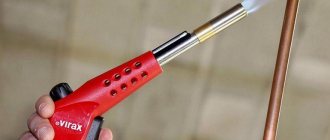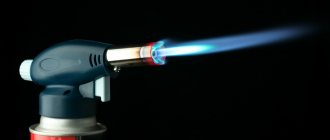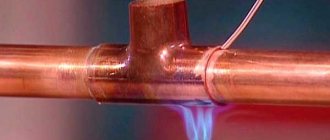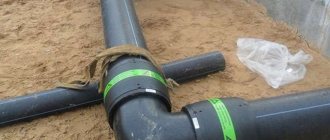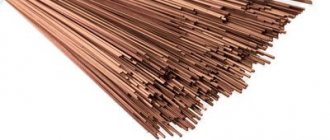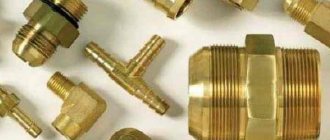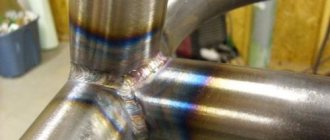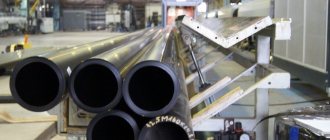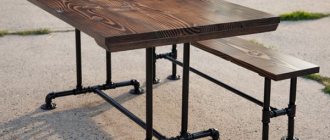Soldering copper pipes is a simple and reliable way to permanently connect a pipeline. Copper is one of those metals that lends itself well to soldering. However, in order to do the work yourself, you must adhere to safety rules and have certain knowledge.
Soldering copper tubes
To understand how to solder copper pipes, you need to study the technology of the soldering process, the list of equipment and tools for the work.
Pipeline connection technology
Copper is an excellent material for communications such as water supply, heating and gas pipelines. Copper products have a lot of positive characteristics, namely:
- Do not corrode;
- Have a smooth surface;
- Not afraid of ultraviolet radiation;
- They have bactericidal properties;
- They have high thermal conductivity;
- Withstands high temperatures;
- Durable;
- Durable.
Despite the fact that copper is a relatively expensive material, it is increasingly being chosen when arranging communications. To make the pipeline strong and durable, it is better to solder it. According to regulatory documents, there are two types of soldering:
- High temperature;
- Low temperature.
Torches for soldering copper pipes
High-temperature soldering is used where particularly strong connections between parts are required. In everyday life, high-temperature soldering is used to repair copper and brass products in cases where there is no other alternative.
Soldering copper pipes with your own hands is a completely doable task. The technology used to solder products involves the use of elements such as:
- Solder;
- Flux;
- Brush;
- Burner.
Safety precautions when soldering copper pipes
One should never ignore safety precautions when a person is interested in how professionals solder copper products. First of all, you need to remember that any copper structure becomes very hot when exposed to a burner flame. Therefore, under no circumstances should you take the part with unprotected hands. You can use pliers to move short elements. It is recommended to wear mittens.
It is necessary to prevent flux from coming into contact with the skin. If such a situation does arise, then the aggressive composition is washed off with soapy water.
Work must be performed in thick clothing. It is recommended to wear cotton items. Clothes made from synthetic fabrics cannot be used during soldering, because artificial fibers easily melt.
The process of joining parts must be performed with good ventilation, since the flux often catches fire during soldering. Therefore, dangerous vapors appear in the air.
After completing installation work, the system must be washed with water. It should be hot and clean. This allows you to get rid of excess consumables inside the pipeline.
Special cases of solder joints
The technology of permanent soldering of pipes involves introducing solder between them. Solder has a melting point slightly lower than copper. Soldering products involves a capillary effect, in which wetting occurs and the solder spreads over the entire surface. Solder is produced in the form of wire.
Soldering copper with the following metals presents some difficulty:
- Aluminum;
- Brass;
- Stainless steel.
The technology by which copper is joined with aluminum, brass and stainless steel differs from others and involves the use of special solders and fluxes. The connection of copper with such metals cannot be soldered in the usual way due to the fact that an oxide film instantly forms on the surface of the products.
Required elements for soldering
In order to solder copper to aluminum, you must:
- Remove the oxide film;
- Cover the surface of the products with rosin.
Also, the connection of copper to brass is carried out using solid copper-phosphorus solder.
What is needed for soldering non-ferrous metals
In order to solder copper, brass and bronze pipes, you need to ensure that you have special tools and materials for soldering, the price of which may vary. Such tools include portable gas torches, oxy-fuel units (soldering stations) or electrical devices. As well as various consumables for soldering, in particular hard and soft solders, fluxes. All this can be found in the catalog “Tools and materials for soldering and welding” of our company.
What is flux used for?
Flux is a special paste or powder that cleans the surface of products from dirt and oxides, and also promotes better spreading of solder. Another important point is that the flux performs a protective function against oxygen entering the joint. Today there are the following types of flux:
- Anti-corrosion;
- Acidic;
- Acid-free;
- Activated.
Flux for soldering copper must meet the following requirements:
- Have a melting point lower than the solder temperature;
- Evenly cover the surface of the product at the soldering site;
- The flux must completely dissolve copper oxides.
Flux for soldering copper pipes
Flux must be used to protect the metal from interaction with air, resulting in a high-quality and reliable connection of parts.
After completing the work, it is imperative to thoroughly rinse the joint and remove any remaining flux to avoid the formation of corrosion at the junction of the parts.
What tools are needed for soldering?
In order to solder copper parts at home, you need to have a set of tools. The main tool is a soldering iron, which performs the function of heating parts. You will also need the following set of tools for work:
- Pipe cutter;
- Chamfer;
- Pipe expander;
- Hammer;
- Roulette.
A gas burner is most often used as a soldering iron, the operation of which is that gas is supplied from a built-in canister. Thanks to the tip heating system, the gas burner is ready for use in just a few seconds. Gas burner comes in the following types:
- For one-time use;
- With a stationary cylinder;
- Acetylene-oxygen.
Gas torches for soldering copper pipes
The gas burner differs according to the following criteria:
- Power;
- Productivity;
- Gas composition.
In order to connect pipes on construction sites or other public utility facilities, you need powerful equipment - a device with a stationary gas cylinder.
To connect pipes at home, a household device with a disposable cylinder is suitable.
Such equipment has a lot of positive advantages:
- Mobility;
- Multifunctionality;
- Adjustable heating speed;
- Security.
A high-quality gas burner should have a bright blue flame. To refill the burner, regular lighter gas is suitable, which works on the same principle.
The composition of the gas differs depending on the type of soldering. There are the following types of gas mixture composition:
- Gas – air;
- Gas - oxygen.
Gas torch for soldering copper pipes
Tool Features
The electric soldering iron for copper pipes is primarily designed for low-temperature soldering. Most models create a temperature of four hundred and fifty degrees. For such soldering, soft solder is used: tin-lead or tin-copper.
There are various types of tools available for sale. There are models powered by a standard 220 V power supply. There are soldering irons that require the use of step-down devices to operate. The first option is easier than the second.
When choosing a tool, you need to pay attention to some of its characteristics:
- power;
- heating temperature;
- weight.
The heating rate and the maximum diameter of pipes that can be soldered depend on the power of the device. The higher it is, the faster copper soldering is carried out. The weight of the instrument indicates the degree of mobility of the device. If you need to constantly move between several objects, you should choose a device with light weight.
Heating temperature is also an important parameter. Modern models of electric soldering irons can be used for both low-temperature and high-temperature soldering. There are devices in which this indicator is equal to nine hundred degrees.
Please note that the type of device in question is not suitable for soldering small cross-section copper wires. For this purpose, it is more correct to use the most ordinary electric soldering iron with a power of up to one hundred watts.
Devices for soldering at home
Household gas burners with a disposable cylinder operate on a gas-air mixture. This tool is lightweight and is great for soldering pipes with a small diameter. The gas-oxygen mixture is used to fill stationary cylinders where professional equipment is needed. In order to connect pipes, equipment such as construction hair dryers can also be used.
Before using the tool at home, you need to carefully read the instructions.
Today, equipment for soldering copper products is produced by both Russian and foreign companies. Among the large selection you can find both professional equipment and small burners for home use. Each company's tool differs in purpose, quality and price.
Gas-burner
The main working tool of a copper pipeline assembler is a soldering iron or gas torch.
The tool consists of the following elements:
- a nozzle from which fire comes out, which is required to heat the pipes at the soldering site;
- plug holding the nozzle;
- a capsule through which gas from the cylinder enters the nozzle;
- tube connecting the nozzle to the handle holder;
- pens;
- hose connecting the burner to the gas cylinder;
- a shut-off and control valve designed to both shut off gas and limit the amount of gas flow;
- gas cylinder.
Basic elements of a gas torch for pipe soldering
Burners used for soldering copper pipes operate on the following types of gas mixture:
- propane;
- butane
Any gas can be further mixed with oxygen, which will reduce the amount of fuel needed to do the job.
Experts distinguish:
- household burners;
- professional burners;
- acetylene-oxygen apparatus.
Household burners
A household propane torch heats the flame to a temperature of 1000ºС – 1500ºС, which is quite enough for soldering. This device is equipped with a small disposable cylinder.
Burner for home use
The advantages of a household burner are:
- mobility. The device can be freely moved in space and soldered even in hard-to-reach places, for example, when installing a water supply system in a bathroom;
- multifunctionality. Most burners intended for domestic use are complemented by various types of nozzles, which allows you to regulate not only the power of the output flame, but also the rate of heating of metals;
- safety when using. The maximum level of safety is achieved by installing a check valve on the device, blocking the supply of the gas mixture.
Household torches are most often used for soldering small-diameter pipes, for example, to assemble a pipeline to an air conditioner.
Professional tool
Professional burners, unlike household tools, are able to heat the flame to a temperature of 1500ºС – 2000ºС. In addition, a reusable cylinder can be connected to the device, which is usually filled with a propane-butane mixture. For ease of use, the professional tool is installed in a special box, which ensures the mobility of the device. Additionally, the burner is equipped with:
- valve for shutting off the flow of the mixture, which is located on the handle holder;
- a reducer for adjusting the gas pressure in the burner;
- pressure gauges, which can be used to determine the gas pressure at the inlet and outlet of the reducer.
Gas burner with reusable cylinder
Professional tools are most often used for soldering large-diameter pipes on an industrial scale or when it is necessary to obtain a more even and durable seam, for example, when assembling gas pipelines.
Acetylene-oxygen torches
A separate group includes a gas burner operating on an acetylene-oxygen mixture. Such a device can be both domestic and professional.
The advantages of using an oxygen acetylene torch are:
- increased temperature of the exiting flame;
- efficiency, which is achieved by operating at a higher temperature.
However, you need to work extremely carefully with an oxygen-acetylene torch, because:
- in the room in which pipes are soldered, the level of gas contamination increases greatly, which leads to the need to comply with all safety standards (open windows, absence of flammable objects, etc.), including individual ones;
- the possibility of overheating of the metal, which will lead to deformation and defects.
Instructions for using a gas burner
To solder copper pipes, you will additionally need a soldering kit, which includes:
- flux - a special mixture to prevent metal oxidation, improve adhesion and increase the fluidity of solder;
Composition for improving soldering quality
- Solder is an alloy that fills the space between the pipes being welded.
Weld filling alloy
Flux and solder can be high temperature or low temperature. If a brazing torch is used, a high-temperature flux is selected accordingly and vice versa.
The gas burner is used as follows:
- If the device is equipped with a disposable cylinder, then before use the cylinder is connected to the burner. If a burner with reusable cylinders (professional) is used, then at the first stage it is necessary to open the gas to supply it to the burner;
- the jet emerging from the nozzle is ignited. In household burners, a regular lighter is used for ignition, while professional tools are usually equipped with a piezoelectric element.
The device is ready for use. How to use a household burner with a disposable cylinder, watch the video.
When choosing equipment, you should give preference to trusted manufacturers.
Well-established brands
Copper pipe joining process
To reliably solder copper products, one condition must be met - the work must be carried out as quickly and accurately as possible.
Soldering copper tubes with solder
In order to solder pipes, you must do the following:
- Use a pipe cutter to cut the pipe;
- Process the edge with a chamfer;
- Apply flux evenly;
- Using a torch, heat the connection to the required temperature;
- Add solder to the gap;
- Seal the seam;
- Clean the surface from flux residues.
To solder copper pipes, you do not need expensive equipment or special skills. If all stages are carried out correctly, the result will be an absolutely strong and durable seam.
When working with a soldering iron, it is very important to adhere to safety rules and also use protective equipment such as gloves, overalls and goggles.
Soldering copper pipes with your own hands is not a complicated technology and is quite feasible even for beginners.
